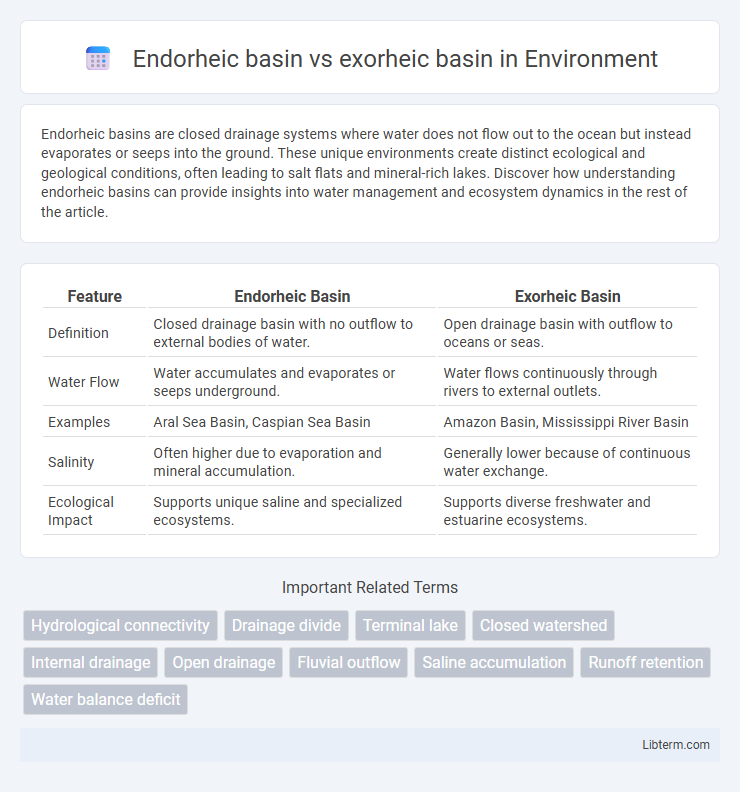Endorheic basins are closed drainage systems where water does not flow out to the ocean but instead evaporates or seeps into the ground. These unique environments create distinct ecological and geological conditions, often leading to salt flats and mineral-rich lakes. Discover how understanding endorheic basins can provide insights into water management and ecosystem dynamics in the rest of the article.
Table of Comparison
| Feature | Endorheic Basin | Exorheic Basin |
|---|---|---|
| Definition | Closed drainage basin with no outflow to external bodies of water. | Open drainage basin with outflow to oceans or seas. |
| Water Flow | Water accumulates and evaporates or seeps underground. | Water flows continuously through rivers to external outlets. |
| Examples | Aral Sea Basin, Caspian Sea Basin | Amazon Basin, Mississippi River Basin |
| Salinity | Often higher due to evaporation and mineral accumulation. | Generally lower because of continuous water exchange. |
| Ecological Impact | Supports unique saline and specialized ecosystems. | Supports diverse freshwater and estuarine ecosystems. |
Introduction to Drainage Basins
Endorheic basins are closed drainage systems where water does not reach the ocean, leading to internal accumulation in lakes or swamps, often resulting in high salinity levels. Exorheic basins, by contrast, are open systems with rivers and streams that drain into the sea or ocean, facilitating continuous water flow and sediment transport. Drainage basins, whether endorheic or exorheic, play a crucial role in hydrological cycles and influence local ecosystems, climate patterns, and human activities.
Defining Endorheic Basins
Endorheic basins are closed drainage systems where water does not flow out to external rivers or oceans, causing it to evaporate or seep into the ground. These basins are characterized by internal drainage, resulting in the accumulation of salts and minerals, often forming salt flats or lakes such as the Caspian Sea or the Dead Sea. Unlike exorheic basins, endorheic basins lack an outlet, which significantly influences their hydrology and ecology.
Understanding Exorheic Basins
Exorheic basins are drainage areas where water flows out to the ocean or external bodies, supporting extensive river systems such as the Mississippi or Amazon. These basins feature open hydrological cycles with continuous surface water discharge, contributing to nutrient transport and sediment deposition downstream. In contrast to endorheic basins, which trap water and form inland lakes or salt flats, exorheic basins play a crucial role in global freshwater distribution and ecosystem connectivity.
Key Differences Between Endorheic and Exorheic Basins
Endorheic basins are closed drainage systems where water does not flow out to the ocean, causing accumulation in lakes or evaporation, while exorheic basins have open drainage that directs water toward seas or oceans. Key differences include hydrological connectivity, with endorheic basins lacking external outlets and exorheic basins featuring continuous flow paths. These distinctions influence sediment deposition, salinity levels, and ecosystem dynamics unique to each basin type.
Geographic Distribution of Endorheic Basins
Endorheic basins are predominantly found in arid and semi-arid regions such as Central Asia, including the Caspian Sea basin, and parts of North Africa like the Sahara Desert, where internal drainage prevents water from reaching the oceans. These basins are also present in the Great Basin of the western United States and the Australian Outback, characterized by closed drainage systems that culminate in salt lakes or playas. In contrast, exorheic basins are distributed globally and feature external drainage networks that discharge water into oceans or seas.
Global Examples of Exorheic Basins
Exorheic basins, characterized by outward water drainage into oceans or seas, include major global examples such as the Amazon Basin, Mississippi Basin, and Nile Basin, which significantly influence hydrological cycles and biodiversity. These basins facilitate nutrient transport and sediment deposition in coastal ecosystems, supporting extensive agricultural and urban populations. In contrast, endorheic basins, like the Caspian Sea and Great Salt Lake, retain water internally, leading to high salinity and unique ecological conditions.
Hydrological Processes in Endorheic vs Exorheic Basins
Endorheic basins are closed drainage systems where water does not flow out to external bodies like oceans, resulting in accumulation through evaporation and infiltration processes, often creating saline or hypersaline lakes. Exorheic basins feature open drainage networks with rivers or streams that discharge water and sediments to the sea, facilitating continuous water cycling and sediment transport. The contrasting hydrological processes influence water balance, ecosystem dynamics, and sedimentation patterns unique to each basin type.
Ecological Impacts of Basin Types
Endorheic basins, characterized by closed drainage with no outflow to external bodies of water, create saline or hypersaline lakes that support specialized ecosystems but often face challenges like increased salinity and reduced biodiversity. Exorheic basins, with open drainage systems flowing into oceans or seas, maintain freshwater habitats that support diverse aquatic and terrestrial species while facilitating nutrient exchange and sediment transport. The contrasting hydrological dynamics of endorheic and exorheic basins directly influence ecological processes, habitat connectivity, and the resilience of local biomes.
Human Activities and Basin Management
Endorheic basins, characterized by closed drainage systems with no outflow to external bodies of water, require specialized management to address issues like increased salinity and water scarcity, often exacerbated by irrigation and industrial activities. In contrast, exorheic basins have open drainage systems flowing into oceans or lakes, facilitating easier management through conventional flood control, pollution mitigation, and water resource allocation. Effective basin management in both types necessitates integrated approaches involving sustainable water use, pollution control, and adaptation to human-induced changes to preserve ecological balance and support livelihoods.
Significance for Climate and Water Resources
Endorheic basins, characterized by closed drainage systems, trap water in inland lakes or swamps, significantly influencing local microclimates by promoting higher evaporation rates and salt accumulation. Exorheic basins drain into oceans, supporting dynamic water cycles and sustaining regional freshwater availability, which is crucial for agriculture, drinking water, and ecosystem health. Understanding these basin types aids in managing water resources and predicting climate impacts, especially in arid and semi-arid regions where water scarcity is prevalent.
Endorheic basin Infographic

 libterm.com
libterm.com